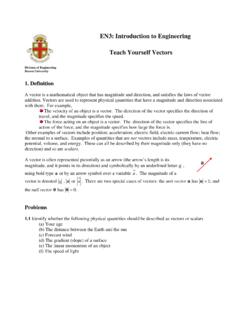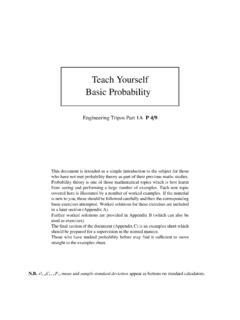Transcription of Teach Yourself Java in 21 Minutes - LTH
1 Teach Yourself java in 21 Minutes1 Teach Yourself java in 21 MinutesDepartment of Computer Science, Lund Institute of TechnologyAuthor:Patrik Persson Contact: is a brief tutorial in java for you who already knowanother object-oriented language, such as Simula or C++.The tutorial is organized as a number of examples showingthe details of java . The intention is to give you enoughinformation about the java language to be able to follow thecourse in real-time are books claiming to Teach you java in 21 days, butsince you already know object-orientation your learningtime will probably be closer to 21 Minutes hence the document may be freely copied and distributed for non-commercial use. In case ofchanges or enhancements,title,department,author, andcontactmust be preserved, andchanges that are redistributed or made public must be mailed to the contact of contents1 Simple declarations and expressions.
2 Declarations .. expressions and conversion (casting) ..42 Statements .. statements and boolean expressions .. and for statements ..63 Classes and objects .. to classes: constructors .. main method .. and exceptions .. new exceptions .. packages .. to the complete java program ..15 Teach Yourself java in 21 Minutes2 What is java , and why?The java programming language was developed at Sun Microsystems and originallybecame popular as a language for Internet applications (applets). Such applets are embed-ded within WWW pages and executed in the user s browser. A special format calledbytecodeis used instead of ordinary machine code, and by using a special java interpreter pro-gram that code can be executed on any computer. Such an interpreter is called a java Vir-tual Machine (JVM) and is available for most modern computer systems.
3 (There is nothing about the java language itself that enforces the byte code technique there are actually some compilers who generate real machine code, known as native code,directly.)The java language is not limited to Internet applications. It is a complete general object-oriented language and can be used to develop many kinds of applications. Although thesyntax of java is very similar to that of C++, many complicated and error-prone features ofC++ have been removed. The result can be described as a Simula with C++ Microsystems (who created the java language) provide free tools for developing Javasoftware. The java home page< > has links to java compilers formost computer systems (such as Unix and Microsoft Windows), as well as a lot of docu-mentation. It is possible to download a java compiler and use it for and running java programsIn java , every source file usually contains exactly one class.
4 The file must have the samename as the class; a class namedTurtleMaze would be stored in the source This source file can then be compiled using thejavac compiler:% javac output of the compiler is a file with the same name as the source file, but with instead ( , in the above example). Thatclass file contains the byte code mentioned earlier, so it cannot be executed right it is executed using the JVM (byte code interpreter) as follows:% java TurtleMazeThis command loads theTurtleMaze class and executes itsmain method (that is, startsthe program). If theTurtleMazeclass in turn uses other classes, these are loaded automat-ically when every class should be in its own file, several files can need to be recompiled at thesame time. Thejavac compiler has a special option-depend to compile all files thatdepend on a particular file.
5 The command% javac -depend compile not , but also all changed files it depends Yourself java in 21 Minutes3 Finding out more about JavaMany details of the java language have been left out in this tutorial. If you want to knowmore about the java programming language, refer to one of the following sources: Per Holm:Objektorienterad programmering och java . Studentlitteratur, 1998. Mary Campione and Kathy Walrath:The java Tutorial(second edition). Addison-Wes-ley, 1998. Also available on WWW:< >. Ken Arnold and James Gosling:The java Programming Language (second edition).Addison-Wesley, 1998. Sun Microsystems: java Technology Home Page:< >. Includesdetailed documentation about the java class you have a question about java which this short tutorial does not answer, feel free to askany of the teachers in your Simple declarations and expressionsThis section shows how to declare and use variables of the simple types, such as integersor booleans.
6 Declarations and uses of object references are shown in Section 3 on page that declarations and statements can be mixed freely (in contrast to Simula andPascal). Simple declarationsJava supports the usual set of simple types, such as integer, boolean, and real are a few of the most common ones:int m, n;// Two integer variablesdouble x, y;// Two real coordinatesboolean b;// Either true or false charch;// A character, such as P or @ Numeric expressions and assignmentsNumeric expressions are written in much the same way as in other = 3 * (5 + 2);x = y / ;n = m % 8; //Modulo, n is now (m mod 8)b =true;ch = x ;Note: the assignment is written using = as opposed to := in many other symbol, == , is used to compare two values to each other (see Section onpage 5). If you try to compare two values using = you will get an Yourself java in 21 Minutes4It is possible to assign a variable an initial value directly when declaring it.
7 Example:double f = ;boolean flag =true;Unlike Simula, the initial value of a local variable is undefined (unless, of course, an initialvalue is explicitly given as just shown).Pitfall: differences between integer and real divisionThe java division operator ( / ) can actually mean two different things: real division forreal numbers, and integer division for integers. Usually this is not a problem, but it canoccasionally lead to some surprising results:double f;f = 1 / 3;// f is now = / ;// f is now the first case an integer division is performed, giving an integer result (0). To get theresult , the 1 and 3 are expressed as real values ( and ), which means thedivision becomes a real Type conversion (casting)In some languages it is possible to assign, for instance, a real value to an integer value is then automatically converted (in this case, rounded) to the right does not perform all such conversions automatically.
8 Instead the programmer mustindicate where the conversions must be made by writing the desired type in parenthesesbefore the expression. In java , such a conversion is called acast. Example:double radians;int degrees;..degrees = radians * 180 / ; // Errordegrees = (int) (radians * 180 / ); // OKIt is, however, possible to assign an integer value to a real variable without casting. In gen-eral, no cast is necessary as long as the conversion can be made without any loss of StatementsJava statements are written in much the same way as in other languages. Just like in Sim-ula or Pascal, statements can be grouped together in blocks using { and } (correspond-ing tobegin andend in these languages). Teach Yourself java in 21 If statements and boolean expressionsA simple if statement is written as follows:if (n == 3) x = ;Note: There is nothen keyword The condition must be of boolean type and written within parentheses Comparison is made using == There are of course a number of other comparison operators, such as < , > , <= , >= ,and so on.
9 The only one that looks different from Simula and Pascal is the not equals operator != , which is used in the example (x != 0) y = / x;// Executed when x is non-zeroelse y = 1;// Executed when x is zeroPitfall: semicolons and else statementsNote that, unlike Simula and Pascal, there should bea semicolon before theelse key-word in the example , when one uses braces ( { and } ) to form a block of statements,the rightbrace should NOT be followed by a semicolon. (In fact, a right brace is never followedby a semicolon in java .)if (x != 0) { y = / x; x = x + 1;}else// <--- Note: no semicolon y = 1;It is common practice to always include the braces, even if they only contain a single state-ment. This avoids forgetting them whenever another statement is about boolean expressionsFor boolean expressions, one needs to use logical operators corresponding to and , or ,and not.
10 In java , they are written as follows:and&&or||not! Teach Yourself java in 21 Minutes6 For example:int x, y;boolean b;..if ((x <= 9 || y > 3) && !b) { b =true;} While and for statements// Calculate exp(1). End when the term is less than sum = ;double term = ;int k = 1;while (term >= ) { sum = sum + term; term = term / k; k++;// Shortcut for k = k + 1 }As the example shows, there is nothing special about java s while statement. The for state-ment is quite general and can be used in some very advanced ways. However, the mostcommon use is to repeat some statement a known number of times:// Calculate 1 + (1/2) + (1/3) + .. + (1/100)int i;double sum = ;for (i = 1; i <= 100; i++) { sum = sum + / i;}As indicated in these examples, the statementi++ is a shortcut fori = i + 1. Actually,there are at least four ways to increment an integer variable1:i = i + 1;i++;++i;i += 1;As long as these statements are not used as parts of a larger expression, they mean exactlythe same thing.










